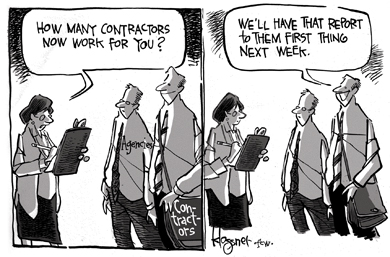Editorial: A fresh take on contracting
Does the intelligence community rely too much on contractors?
The Office of the Director of National Intelligence made some headlines last week when it published a study showing that contractors made up 27 percent of the National Intelligence Program workforce. Much of the coverage raised the question that prompted Congress to request such reports in the first place: Does the intelligence community rely too much on contractors?
That debate will continue. However, the report ought to prompt another question: How many other agencies could provide such a detailed accounting of their contractor workforce?
It’s not just a matter of knowing the ratio of contractors to government employees. It’s also important to understand what work contractors are doing and why.
In recent years, the debate about outsourcing has focused on differentiating between those jobs that are inherently governmental and those that are not. Although that issue is integral to the Bush administration’s competitive sourcing (now called commercial services management) initiative, it is not a useful management tool.
And that is a critical perspective: The contractor workforce ultimately must be viewed as a management
resource.
In the intelligence community, 56 percent of managers said contractors have unique expertise, according to an ODNI survey of 16 intelligence agencies. Eight percent said they used contractors because of funding uncertainties, and 11 percent said they would hire more government employees if they had more funding. Another 5 percent used contractors to increase staffing levels rapidly, and 3 percent hired contractors for one-time projects.
In contrast, only 10 percent of managers said their rationale was that hiring contractors was more cost-effective than using in-house staff — the basic assumption of competitive sourcing. Clearly, cost-effectiveness is only one of several variables that play into contracting decisions, and it is not necessarily the most important one.
To their credit, ODNI officials defended the size of their contractor workforce by arguing management principles — what makes the most sense in given circumstances — rather than simply relying on policy decisions about which job can be classified as inherently governmental.
Lawmakers and other critics might take issue with that their conclusions, but at least ODNI officials are arguing relevant points and backing them up with concrete data.

NEXT STORY: Firms get $9 million for cryptography work





